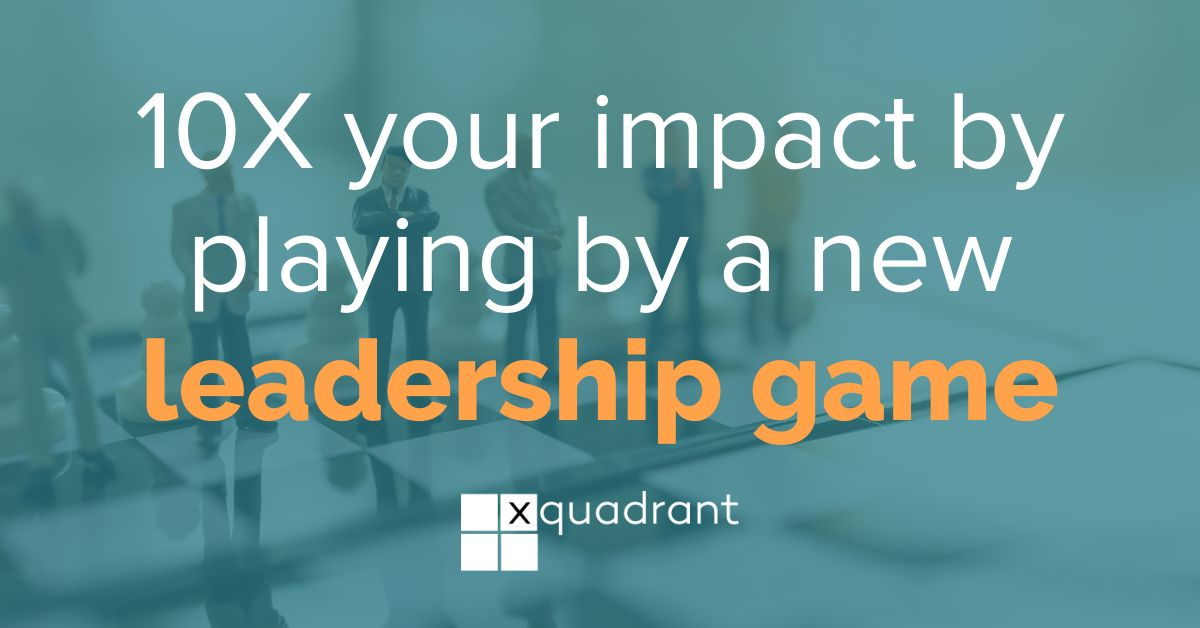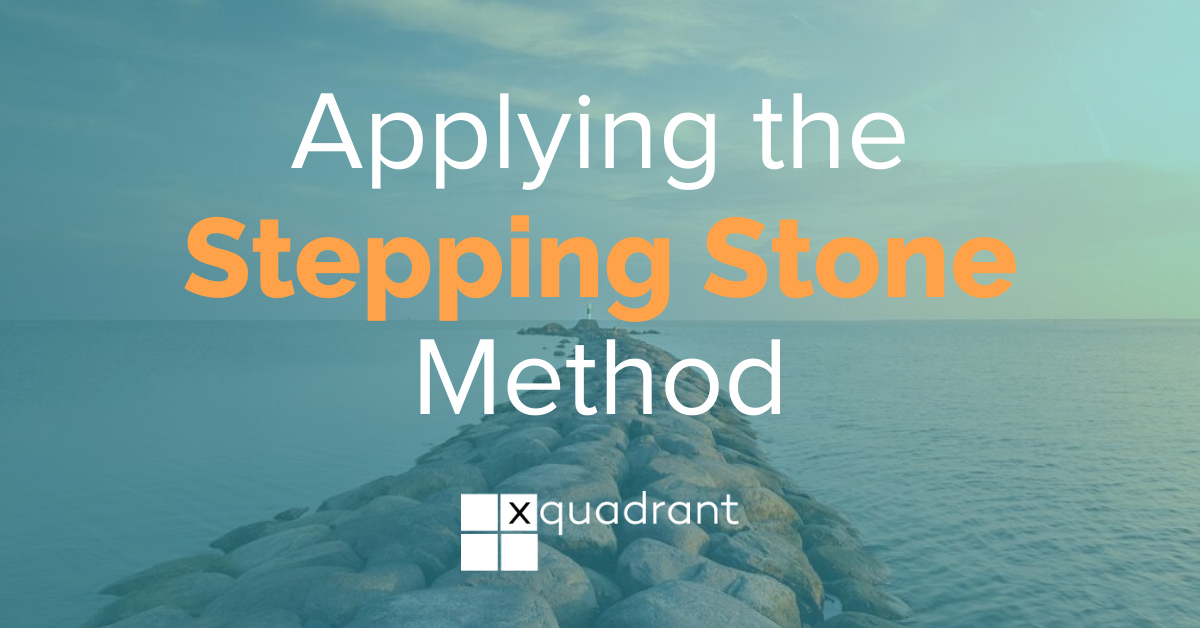Any successful person will eventually come to the realisation that the thing that’s stopping them from achieving greater results is … themselves.
We can (and should!) talk about mindset, skillset, drive, emotional intelligence, and so on. But ultimately what it’s going to come down to are the observable habits and behaviours that result from all of that.
In other words:
How to be a better leader? Adopt better leadership behaviours.
But how do we do that?
Unfortunately, it’s extremely difficult for adults to change their behaviour in meaningful ways. Indeed, you might want to ask yourself “when was the last time I actually did successfully sustain a meaningful behaviour change?”
What’s more, if changing personal habits (like eating, exercise, reading, …) are hard enough, leadership habits involving other people is an even bigger challenge.
Why so?
More...
Firstly, because we’re not just fighting our own ingrained habits. When it comes to leadership behaviours, changing others’ perceptions of us is critical.
For example, imagine a leader who is known for being hard-driving and for publicly ridiculing people who challenge his opinion. The leader might adopt a new behaviour - of being curious and exploring challenges to his viewpoint in an openminded manner - but if the people around him fail to notice this, they will remain fearful and continue not to speak up. Eventually, the leader is likely to give up on this new behaviour, which is not seen as “getting results”.
“If I was to change ONE behaviour that would have the biggest positive impact on my results and my legacy, what would it be?”
Secondly, because the pressure’s on. Our leadership behaviours are responsible for the results we’re getting. So, whilst it makes sense that “better behaviours will create better results”, there can also be a concern that 'if I change things too much, I’ll break what’s currently working and actually lower performance!'
What doesn’t work
I work with many senior leaders on the behaviours they need to adopt to take themselves, and their teams, to a new level.
When looking at how to be a better leader, there are several traps I’ve seen leaders regularly fall into, that stop us making meaningful and permanent behaviour upgrades. I’ll explain how we can avoid all of these traps later. Here they are:
Trap 1: Setting vague leadership objectives. Anyone who’s resolved to “be more strategic”, “listen more” or “be more productive” will know these are dead ends. We need to get a lot more specific if we’re going to set up a game we can win. Now, intellectually we know this but I’m amazed at the number of leaders and teams I work with who, when asked to develop actions and goals come up with incredibly vague and non-specific statements like those above!
Trap 2: Assuming insight is enough. We often believe that “if I understand, I will do.” The fact most of us are carrying a few more pounds/kilograms than we’d like, or rehashing the same old domestic disputes with our spouses, is testament to the fact that knowing we should change our behaviour doesn’t get us very far!
Trap 3: Expecting you’ll resist temptation and that your enthusiasm for your goals won’t dip. We overestimate our own willpower to sustain behaviour change, despite the weight of evidence in terms of failed New Year Resolutions, abandoned diets, expired gym memberships, struggling smokers, and so forth.
Marshall Goldsmith talks about “the planner and the doer” in all of us. The planner is rational and strategic and knows what’s best for us - and tells the doer what needs to happen. But the doer is easily tempted by short-term pleasure and ease and isn’t particularly aware or interested in long-term benefits. When we make our plans, we’re being the “planner” - but days, hours or even minutes later we’ve switched to being the “doer”, and our good intentions are quickly forgotten in favour of whatever's familiar, easy or urgent.
Trap 4: Rejecting help and structure. A particular trap of high achievers is the sense that they don’t need help or structure to establish new habits. It can be almost a badge of honour to say, “I get it and I’ve got this”. But the corporate world is full of high achieving leaders who have plateau’d and are being held back by their longstanding tendencies and behavioural traits that they can’t quite shake.
How to be a better leader? Implement this proven behaviour change framework
Here’s the 6-step behaviour change framework that I find works repeatedly to help high-performing leaders make changes to habits that once served them but now has become a liability and a hindrance.
You can also watch this video on the 6 steps:
If you want to know how to be a better leader and would like to download a one-page ‘cheat sheet’ with all 6 steps, the environment-mapping tool, and a tracking spreadsheet, you can do that here.
1. Find a behaviour that matters
If you want to know how to be a better leader, you need to start by identifying a leadership behaviour that will ‘move the needle’ for you and create dramatic results.
The problem is that most of don’t think there is such a dramatic behaviour change available to us.
Author and fellow exec coach Marshall Goldsmith has asked more than 80,000 professionals to rate their performance.
The numbers can’t lie: this is an incredible level of self-delusion.
It’s human nature: if we experience success, we tend to credit ourselves; conversely, we tend to blame our losses on our situation or on others.
Data is immensely valuable here: if you’re in sales, there are at least some metrics that clearly rate to performance. But even data doesn’t tell the whole story: were your outstanding sales numbers a case of “right place, right time” or do they tell the story of a sustained and strategic turnaround of key accounts?
However, instead of trying to figure out exactly where you lie in your peer group, here are four steps you can take.
Ask yourself the “ONE THING” question…
This is pretty much what it sounds like. Ask yourself:
“If I was to change ONE behaviour that would have the biggest positive impact on my results and my legacy, what would it be?”
Brainstorm a few ideas and circle the top one. Boom.
Run a Leader 360
Of course, the problem with introspection is that our blind spots are just that. We often are unable to see the very think holding us back. So in my coaching work I systematically solicit the viewpoints of others, and I recommend you do too.
One approach is to run a simple “Leader 360” survey. Put something together in Survey Monkey or Google Forms and circulate it to a handful of key people asking for their candid input. This is a crucial step to be a better leader.
Talk to people
You may feel that a Leader 360 survey feels too formal coming from you. If that’s you, then just ask 2-3 trusted colleagues the “ONE THING” question: “If I was to change ONE behaviour that would have the biggest positive impact on my results and my legacy, what would it be?”
Take care to provide some context. For example, “Jack, I’m committed to increasing my impact within the company and to our customers. I’m asking a couple of trusted colleagues for their candid feedback on what’s holding me back, because it’s often hard to see those things yourself. Would you be happy to give me a few minutes of your wisdom?”
Decide how important it truly is
By now you should have a couple of ideas for what you’d like to focus on. But are you really committed to follow through? One thing I recommend to my clients is that they consider the stakes by thinking through:
You may like to ask these 2 questions to your colleagues too!
A CFO client of mine was interested initially in “ongoing professional development” - until he spoke to some important colleagues who explained the uncomfortable truth that unless he pulled himself out the details and communicated on a more strategic level with his shareholders, his job was at risk. Suddenly, we had motivation, focus and urgency and progress was almost immediate!
Action Point: Review your answers to these questions, and decide 1 or 2 behaviours, no more, that you are truly committed to work on.
2. Identify specific ‘moments of truth’
Once you’ve determined the specific behaviours you want to work on, identify specific moments of truth.
Moments of truth are the actual situations where you’ll be challenged in these behaviours, and will have a choice to lapse into automatic mode or to step up to a new and more helpful behaviour.
I generally advise clients to consider these three angles:
By moving from generalities (“I need to be more patient”) to specifics (“I need to be more patient when I’m at the project review meeting and senior leaders ask me irrelevant or tedious questions”), you start to set up a game you can win.
As an example, a Chief Technology Officer client of mine identified that he had to be more confident and concise. We then identified the high-impact “moment of truth” for this behaviour - a specific regular product development meeting that was widely attended by his extended team. Once this was done, then implementation became pretty simple.
Action Point: Write down 1-2 moments of truth where you’ll have an important, meaningful opportunity to practice these behaviours.
3. Involve people who matter
Leadership behaviours are different from individual behaviour change. If you want to work out more, it’s largely up to you. But if you want to be a more inspirational leader, say, then the perceptions of the people you are trying to lead are the reality!
The issue is that perceptions often lag reality. We’ve changed, but others haven’t noticed. We’re listening more, but people still assume we’re not listening. We’re controlling our temper, but we’re still labelled as hot-headed. These perceptions can actually drag us back to our prior state. After all, if we’re not getting the recognition it can be easy to think “why bother?”
One tool we use to both measure perceptions and close the gap between perception and reality is the “pulse check”. You simply need to ask three to five supporters for their view on how far they’ve seen you do “behaviour A” in the last month, and ask for their recommendations on how to do “behaviour A” even better next month. Repeat this every month.
Again, it’s important to ask these supporters upfront for their commitment to observe and provide this feedback over a specific period (say 6 months). So it can feel daunting but it’s incredibly powerful and a game-changer for most clients.
The benefit of doing this is not just the feedback that you get. It’s actually that your supporters actually have to observe a very specific behaviour of yours over a period of time. So if you change, they’ll see it - and their perceptions will more closely follow reality.
Action Point: Write down the names of 3-5 supporters who can give you feedback and advice on your behaviour change.
4. Build a zero-effort environment
Environment is extremely powerful - far more than we realise.
Why? Because we get tempted by temptation works far easily that we think we will!
A highly successful entrepreneur I know arrived in a hotel for a six-day stay. Resolving not to eat the chocolates and crisps in his room, he was about to call room service to have them removed, before thinking “I’m a strong person. I’ll just put them out of sight, under the bed. No problem.” He resisted temptation for 5 days — then, in a particularly tired and stressful moment, they caught his eye and he scoffed the lot!
So we can manage our environment, it’s helpful to think about it in two dimensions:
In other words - do we need it (helpfulness) and do we want it (attractiveness).
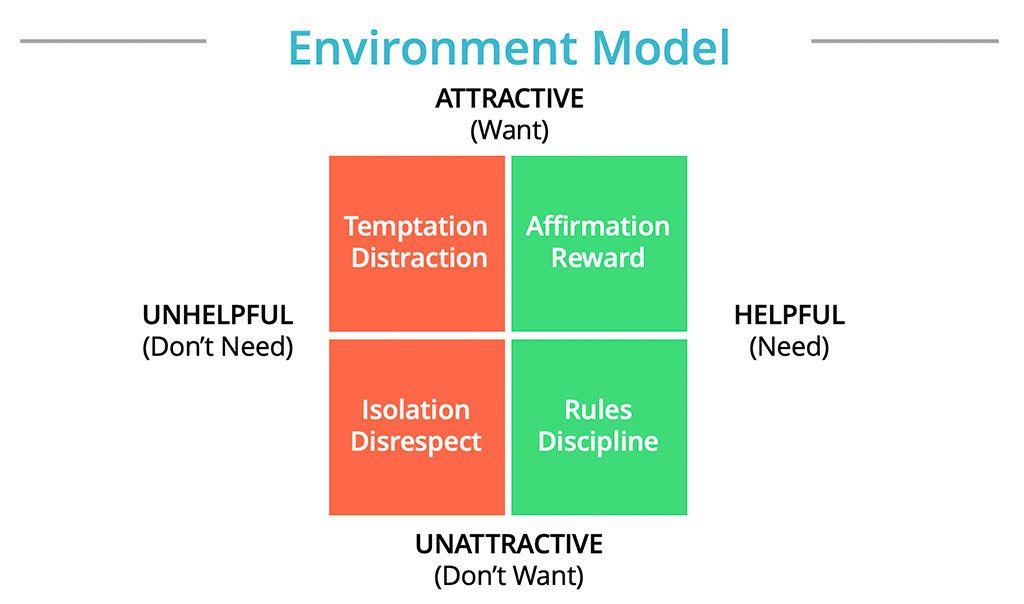
Have a look at the diagram, and let’s map onto it the different aspects of the environments that you find yourself in over the course of a typical week.
Here’s an example for a simple habit such as losing weight:
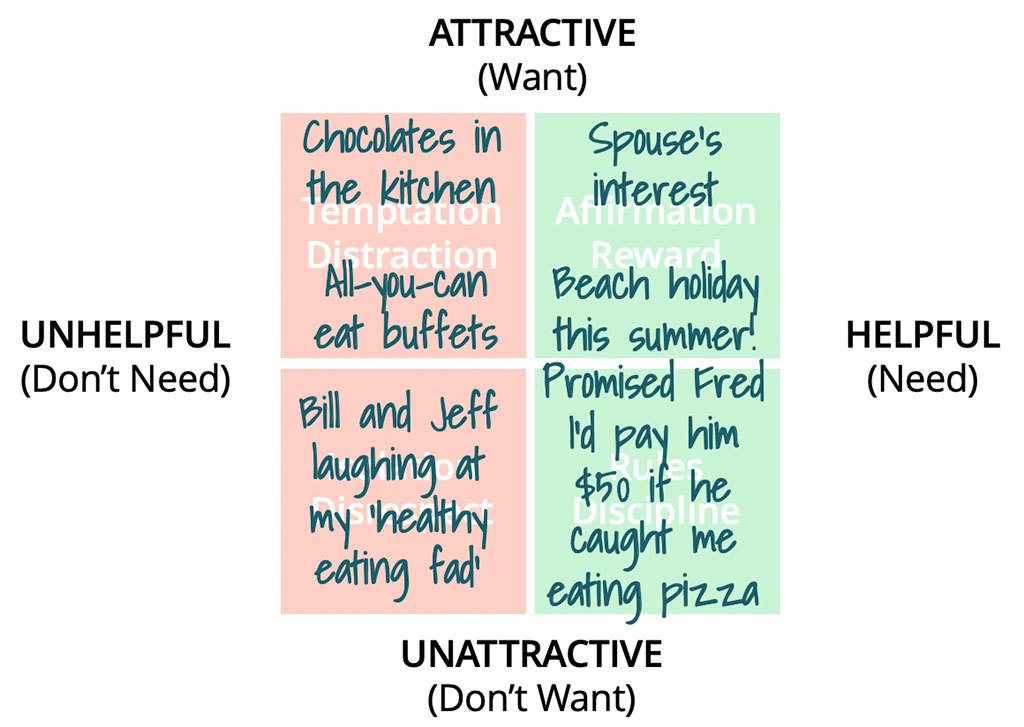
There are several unhelpful factors at work:
Also, the person has identified and put in place some helpful factors to encourage weight loss:
These are all pushing the individual towards success.
You can see that if you stack your environment to the right of the diagram, success becomes almost inevitable.
And here’s an example for somebody developing a leadership habit: “coaching, rather than directing, my team”:
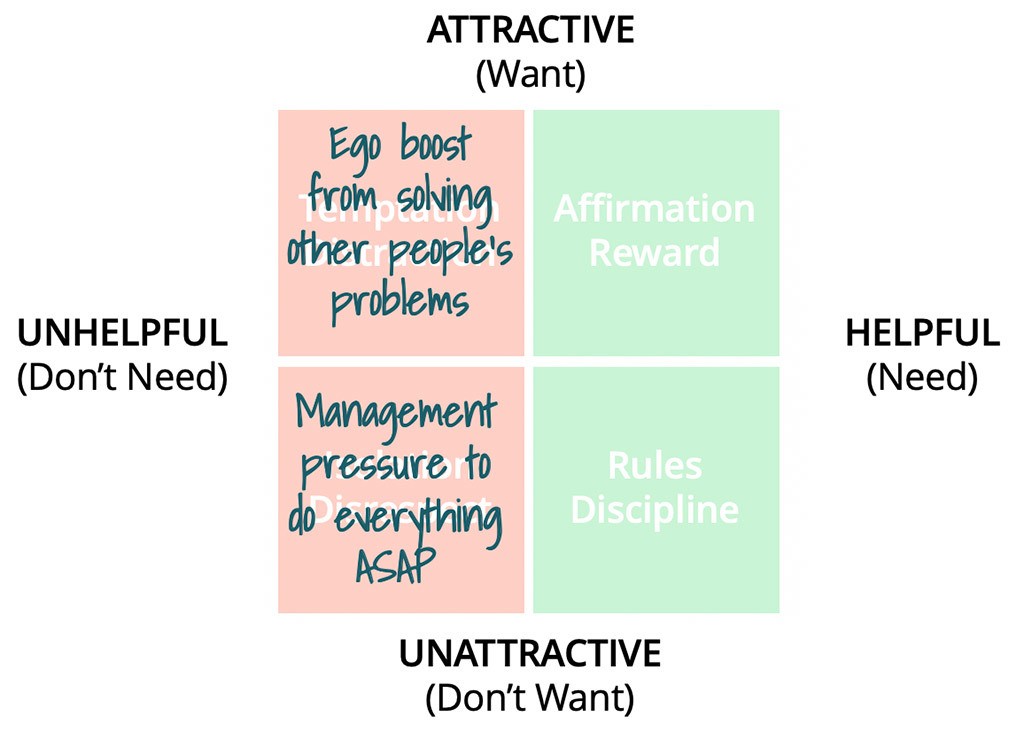
You can see right now that the environment isn’t favourable. There’s an immediate ego boost coming from “directing” behaviour - and there’s management pressure to decide and do things fast.
Unless the individual addresses these aspects, and puts things in place on the right hand side of the chart, this behaviour change is pretty much doomed.
The key in managing your environment is to make one-off decisions that reduce future temptations. Implement a change now, so you don’t need to use willpower later.
5. Anticipate war zones
Once you’ve mapped out your environment and hopefully taken a few temptations off the table, you need to face your ‘war zones’.
These are the dangerous, tempting environments that you can’t completely avoid.
The solution here? Clearly anticipate the specific situations, and decide on your actions beforehand.
In the example above, perhaps you can’t avoid all the all-you-can eat buffets in the world. You know your friend is having a big birthday bash. So the morning before, you imagine walking in, all the food and drink on the table. Perhaps you decide you will take one plateful of food only, and only at 9pm. You also decide to announce this as soon as you arrive to three of your best friends (perhaps telling them you’ll pay them $100 each if you slip up). You also decide that you’ll just have one beer, then move to the Diet Cola. Do you see how this kind of anticipation will improve your chances of success on your weight-loss programme?
The same applies in leadership environments. When you can anticipate the specific moments when the environment is going to push you into unhelpful behaviour, you can develop strategies ahead of time to force you to take an alternative course of action.
Action Point: Conduct an ‘environment review’ using the helpfulness/attractiveness matrix and make some decisions to stack the odds of success in your favour. Remove yourself from tempting situations, and add real consequences and accountability to push you to follow through.
6. Actively monitor your effort
Up to this point, we’ve been functioning as “planner”. We now need to address the “doer” in us and keep them accountable to do what we’ve determined is the best course of action.
The key to this is to maintain ongoing awareness of the behaviour and of your progress. The problem is that life happens, and sometimes there’s no opportunity to even practice a specific behaviour for days.
So - how can you remain emotionally engaged and connected to your behaviour change goal?
Well, rather than focusing on outcomes (which lots of external factors may influence), focus on intent.
If you ask, say, “did I work on my top priorities today?”, you may well say “er, no, because my boss dumped a fire-drill on me and a customer situation blew out of control”. So a negative result, but lots of valid excuses.
But if you ask a modified question: “did I do my best to work on my top priorities today?”, you can say “yes” despite the fact of not making much progress. Or you can make some progress but have to admit that you got distracted for half the day by low-value tasks.
“Did I do my best to....?” forces you to analyse the level of emotional engagement you have with your desired behaviour. If you ask yourself the question each day, the awareness and engagement level can’t help but rise. I highly recommend it. This is how to become a better leader, in practical implementation reality!
My clients track their core behaviours in the Xquadrant Hub app, allowing them and me to see and measure progress. You can use another tool, such as a tracking spreadsheet. You can get a copy of this spreadsheet here, in the resources bundle for this article.
Action Point: Set up your tracking mechanism, with the “did I do my best to” questions.
Next Steps: For professionals only
Now you know how to be a better leader: upgrade specific behaviours in specific moments of truth to create a new reality. It’s easier said than done, but the 6 steps outlined in this article are - if you follow them - a proven way to make change happen.
If you’re truly serious of course, you may want some help to identify and follow-up on the right behaviours. If you’re ready to play a bigger leadership game, you might like to apply for a complimentary strategy session where’ll map out what the next level looks for you.

